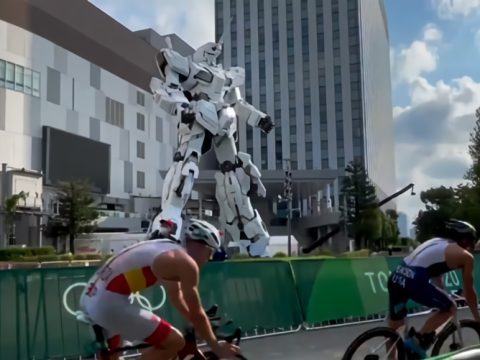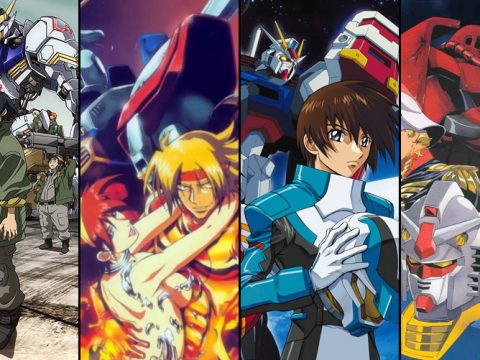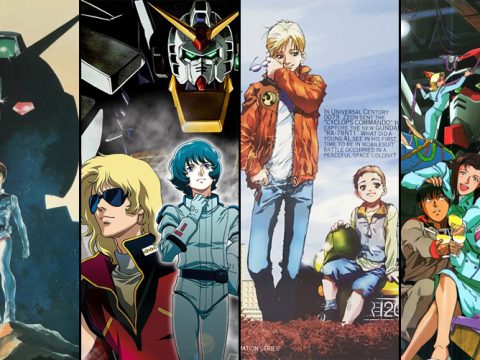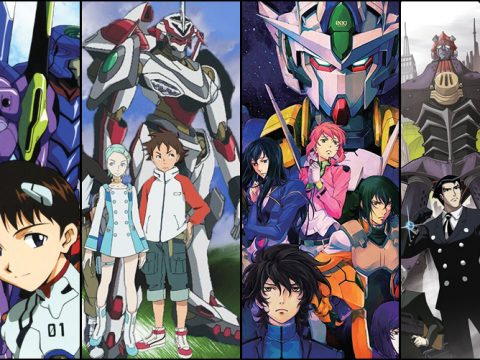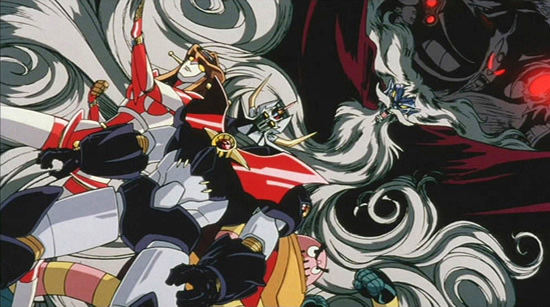
With Mazinkaiser SKL residing at or near the top of my “absolute must-purchase anime of 2011” list, I thought now would be a good time to reflect upon the original Mazinkaiser anime from a decade ago. Wow, has it been THAT long already? Indeed it has, but before we get into that, I suppose I should start at the beginning…
Personally, I like anime that features blood. I also like anime with giant robots in it. The best thing in the world therefore is anime featuring giant robots that BLEED, and if you saw that robot picture and clicked this article regardless that means you too most likely crave “the finest violence for those who fear not even God,” as the theme song goes. When it comes to providing that, Go Nagai is the Alpha and Omega.
The torchbearer of giant robot carnage is the “super robot” Mazinger Z, piloted by ever-impetuous hero Koji Kabuto. He’s a hot-blooded high school student whose crazy scientist grandfather built the giant robot Mazinger Z to stand up to the evil forces of the ideally named Doctor Hell, who is perhaps the most delightfully melodramatic evil villain anime has to offer. Whoever could have ever guessed that a guy with a name like “Doctor Hell” that looks like a twisted version of Charlton Heston’s Moses would be a bad guy? He’s got a giant pipe organ and lives on an island with his face carved into the mountainside! WHO LET THIS MAN INTO DOCTOR SCHOOL?!
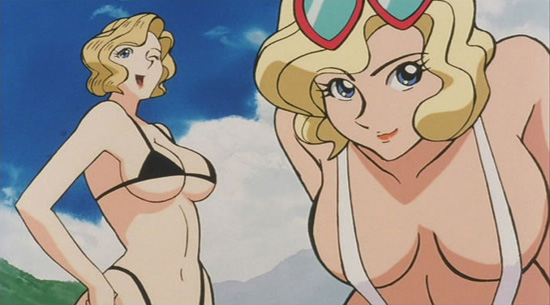
Koji’s parents and grandparents are out of the picture one way or the other, but rather than lament his childhood of parental neglect he relishes the opportunity to jump into his robot, charge headfirst at the enemy without a moment’s hesitation, and save the day while screaming his attacks at the top of his lungs. That’s the beauty of Koji Kabuto: his simplicity. Much like how Superman is the template for classic American superheroes, Koji is the template for classic shonen anime/manga protagonists. Perhaps that’s why Koji’s would-be girlfriend and fellow robot pilot, Sayaka Yumi, is constantly in need of rescuing despite her strong will and ability to pilot lady-shaped robots with breasts that quite literally double as missiles: she’s anime’s equivalent to Lois Lane!
Koji, Sayaka, and the gang have been putting their rocket-propelled fists to the bad guys for roughly 40 years in one form or another, laying the groundwork for a slew of narrative conventions in the process. The original anime series for Go Nagai’s most famous creations are long gone, but they are not forgotten. For as a result of their immortal status as the “original super robot heroes” they’ve been featured within nearly every single Super Robot Wars videogame ever made, which is roughly 20 years (and at least 30 games) worth! The Super Robot Wars games are a topic unto themselves, but suffice it to say that with that many installments, these games were popular enough in Japan that eventually new robots started to be designed just for them, and those robots then became popular enough to merit their own anime adaptations! Such is the manner by which the Mazinkaiser anime came to be.
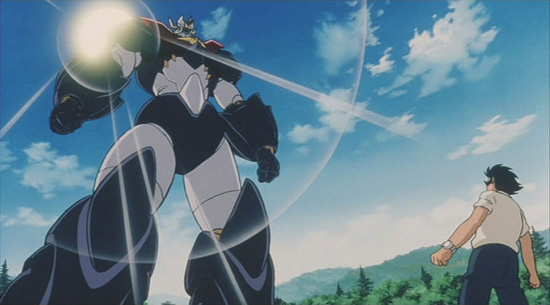
The primary thing everyone should remember about all of the Go Nagai / Dynamic Pro remakes of the last several years is that they’re not sequels to any other anime, not even one another. Their names may be nearly identical, the same characters may show up across several of them, and similar events may occur, but they have no continuity relation between one another whatsoever. There is no need to have seen anything else before seeing the remakes. They’re like the work of Leiji Matsumoto (Star Blazers) in that sense.
Besides, everything anyone TRULY needs to know about the decades-spanning history of Mazinger Z is conveyed within the first five minutes of the first episode of Mazinkaiser. At the behest of Doctor Hell, the half-male/half-female Baron Ashura commands an army of mechanical beasts with which to TAKE OVER THE WORLD. All that can oppose such “Hell”-ish machinations is Koji in Mazinger Z with the occasional help of his friends: the supposedly superior but perennially less popular Great Mazinger commanded by adult (killjoy) Tetsuya Tsurugi, the mostly useless girl robot Aphrodite A piloted by Sayaka, and the “so useless it’s a joke” fat guy robot Boss Borot which is itself driven by a comically useless fat guy named “Boss.”
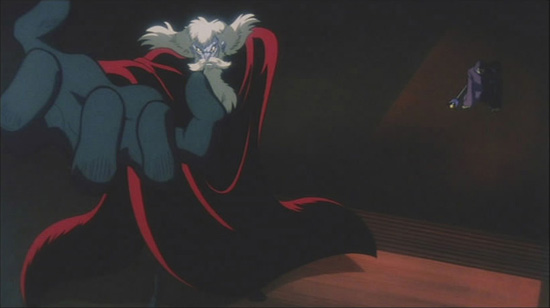
Robots may abound in any Go Nagai super robot series but only ONE is allowed to ultimately save the day, and that’s whichever robot is in the title. Because of this foolproof playground logic, Mazinger Z, Great Mazinger, and the gang get their clocks cleaned, thus allowing Koji to take up the reins of our new robot overlord: Mazinkaiser! In all honesty, this retro-styled giant robot hero for a new era looks pretty ugly, but it certainly lives up to the “demon god emperor” that its name implies. As an even more powerful version of Mazinger Z, Mazinkaiser sports what are effectively upgraded versions of the traditional Mazinger attacks for the most part: the rocket-propelled fist, the energy beams fired from the eyes, the corrosive tornado breath, the chest death ray, and so on. Hey, if it ain’t broke…
Released in 2001, the 7-part OVA Mazinkaiser was certainly not the type of anime intended for most anime fans. It was first and foremost a nostalgia grab for all the people that were children during the 1970s who are now all grown up. Virtually the entire original Japanese voice cast has been brought back to resume their roles 30 years later; ADV Films did create an English dub, but imagine my disappointment to hear that the Christopher Lambert credited was not THE Christopher Lambert of Druids and Beowulf fame! The vocal songs come courtesy of original Mazinger Z theme song artist Ichiro Mizuki and his successors, the then-recently formed band JAM Project. JAM Project or its individual members have contributed vocals for the majority of super robot-related anime and videogames made within the last 20 years. It’s practically a requirement at this point.
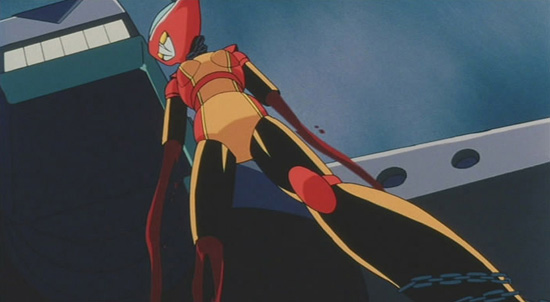
Despite the modern-era quality animation, everything about the production screams “throwback” albeit with one notable exception. The 4th episode feels somewhat out of place with the rest of Mazinkaiser yet completely in keeping with current anime trends. It’s a “let’s go to the beach and see everyone in their swimsuits, primarily the girls!” episode, complete with extended sequences of Sayaka being deprived of her top to the delight of… well, everybody except her. (Post-pubescent though she may be, let the record show that Sayaka is totally underage.) But make no mistake, it’s not like Go Nagai was ever concerned about or shied away from such things to begin with! It’s rather telling that a series featuring giant missiles that fly forth from either the lower abdomen regions of the “guy robots” or the upper chest areas of the “lady robots” is considered one of his most tame in the sex and innuendo department. To be fair, where ELSE would missiles fly out from on a humanoid robot, huh?!
In all seriousness, the reason these machines are shaped like guys and girls is because Go Nagai’s robots are ultimately just extensions of the people who operate them. They look like, use body language, and some even change facial expressions accordingly with their pilots. When these robots sustain damage, oil or some reddish fluid gushes forth from their mechanical bodies the same way a person’s blood would if their guts had just been sliced open by a blade or if their limbs were forcefully torn off. Their robot surrogates can be repaired from such damage much more readily than a human being would, but the pilots still scream in pain as if they themselves had just been mutilated all the same. This defiant lack of concern for “realism” is what makes Go Nagai’s mecha the textbook definition of “Super Robot.”

The works of Go Nagai have been released all over the world to the great delight of children and even greater dismay of parents everywhere: France, Italy, the Philippines, Asia, and much of South America got to see Mazinger Z and its successors throughout the 1970s and 1980s. But American audiences barely saw any of his stuff when it was first coming out the way the rest of the world did. Sure, there was a scattering of attempts to localize his work for US syndication, but the dubbing was either too terrible—think song lyrics such as “Koji can swim in the sky, he can fly beneath the sea” as sung in English by Isao Sasaki, who doesn’t speak English—or the censorship was so substantial that all the good stuff was cut out and you’d never know the show came from Japan in the first place. Unsurprisingly, Go Nagai’s body of work never quite caught on in America as a result, and so his last 15 or so years worth of nostalgia-fueled super robot remake efforts, Mazinkaiser included, have all failed to captivate the vast majority of modern US anime fans. It remains to be seen whether the somewhat more modern-styled character designs of Mazinkaiser SKL will aid its US reception when Media Blasters releases it later this year. Perhaps its replacement of Koji Kabuto with two equally crazy albeit more “pretty” pilots might just give it a chance?
In the meantime, the original Mazinkaiser OVA series can still be purchased on DVD in the US, though your best bet would be to use online vendors such as Amazon or Right Stuf since it probably won’t be on store shelves. The ADV Films 2-disc release uses some questionable choices in Romanization—for instance, Koji’s hovering aircraft that doubles as the cockpit which is commonly called the “Hover Pilder” is called the “Hober Bailder” in their release—and the subtitles sport occasional grammatical errors that suggest a lack of quality control, but these are ultimately minor annoyances.
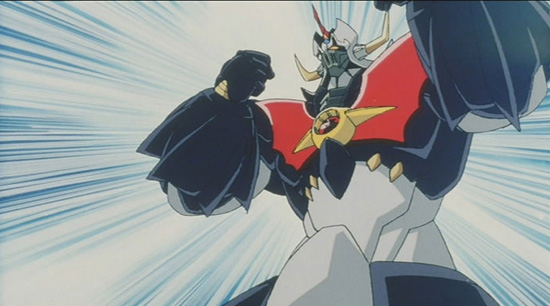
Unfortunately, we never got to see a US release of the second Mazinkaiser OVA, and with a total running time of a little under an hour we probably never will. A one-shot entitled Mazinkaiser: Death! The Great General of Darkness, it was noticeably more gruesome than the previous Mazinkaiser, to which it has no direct relation; before the opening credits have even finished we see some of the supporting cast get crushed into paste and dismembered. The basic premise is patterned after the 1970s movie Mazinger Z vs The Great General of Darkness, albeit with substantially different tone and execution. About three quarters of the running time is spent on Koji traversing the globe in his attempt to rendezvous with the upgraded Mazinkaiser so that he can repel the alien threat; without it, he’s only a little less vulnerable and a little more capable than everyone else. The animation style and high degrees of ancillary cast members being cleaved in half/beheaded establishes trends that would be continued in 2005’s New Getter Robo, released by Geneon… which has no direct relation to the enjoyable yet troubled production Getter Robo: Armageddon, also released by ADV Films. Or the much less grim Shin Getter Robo vs Neo Getter Robo released in the US by… nobody, unfortunately. That last one’s a real shame because it’s so accessible for first-time viewers, and the promotional music videos included as extras were in fact where the Mazinkaiser robot made its anime debut.
A lack of nostalgia combined with a general aversion to the character designs of the 1970s and an overall dislike for giant robots means that this type of anime gets continually passed over without a second glance by the majority of American anime fans. But Mazinkaiser is an inexpensive and acceptable introduction to the mad, mad, mad, mad world of Go Nagai. If you like what you see (and you just might, depending on what aspects of Tengen Toppa Gurren Lagann appealed to you), rest assured there’s plenty more where that came from.


![SSSS.Dynazenon [Anime Review] SSSS.Dynazenon [Anime Review]](https://otakuusamagazine.com/wp-content/uploads/2021/08/16-9-SSSS.Dynazenon_Key_Visual_3.5-480x360.jpg)
![Back Arrow [Anime Review] Back Arrow [Anime Review]](https://otakuusamagazine.com/wp-content/uploads/2021/07/ba15-02686-480x360.jpg)
